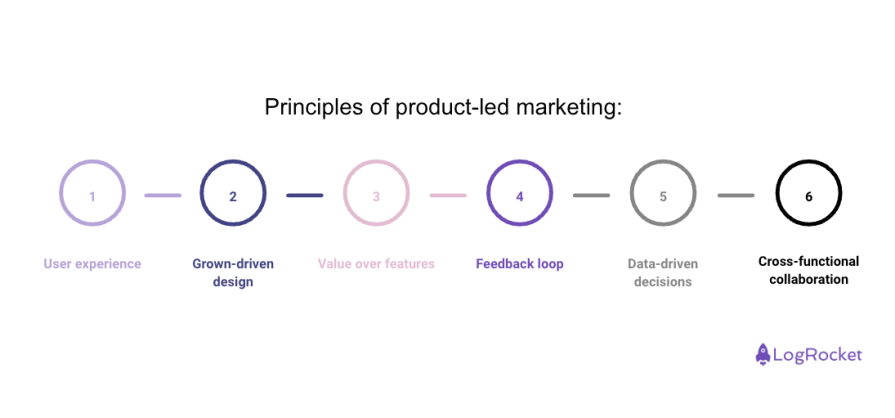Preparing a good marketing campaign is an art. Just like a painter, you need to create a piece that will resonate with people looking at it.

But what should you put on the canvas? Should you focus on the value the marketed product brings? Use popular memes? Maybe show how you look when compared to the competition?
Instead of guessing, you can let the product market itself by utilizing a strategy called product-led marketing. In this article, you’ll learn the insides of product-led marketing, how to set it up as your product strategy, and tools that will help you get the end result you want.
Product-led marketing is a strategy that focuses on the product itself as the main driver of customer acquisition, conversion, and retention. In this model, the product experience is put at the forefront to grow the business and attract users.
This is often achieved by utilizing a freemium or trial model to give the users a taste of the experience of the product before committing to a purchase. Sometimes you might also hear this as product-led growth (PLG).
In order to achieve successful product-led marketing, you need to adopt the following principles for your product:

The product must be great. Once you get the opportunity to use it and see how much it improves the user’s life, the user needs to get hooked. Product-led marketing demands that users fall in love with the product the moment they get their hands on it.
The product has to make it easy to get users to promote the product. This can be done by making it easy to announce using the product on social media, giving benefits for getting more users to use the product, etc. Basically, build your product in a way that makes your users willing sales agents.
Rather than marketing the product based on its features, product-led marketing aims to promote the value the product brings to users. This can be achieved by focusing on how the product can solve problems, improve the user’s life or work, or achieve certain goals. So, the product-led marketing campaign will proclaim “Learn new language easily,” not “use our gamification system in the language learning process.”
Users should have a strong voice in building your product. Because of this, effective feedback loops are essential for a product-led marketing strategy.
Although a feedback loop might tell you what users say they want, data tells you what they actually need in the product. You should always look to balance feedback with data to arrive at a more informed approach.
Marketing, sales, product development, and customer success teams have to work closely together to ensure that the product and the user experience are at the forefront of communication.
Ok, now that you know what product-led marketing is, let’s look at how to approach it in a practical manner.
An effective product-led marketing strategy is slightly different from a regular marketing approach. In the classic take, marketing is a separate “product” promoting the actual product to be sold. On the other hand, in product-led marketing, everything in the product and around it is designed to encourage users to share their experience and feed growth.
Make sure you know what the product wants to solve and focus all actions around it. Stay focused and don’t try to do too much at the same time.
You’ll need to have your teams develop content that educates users about the product and helps them solve their problems.
With SEO, you’ll need to optimize content for search engines to attract users who are seeking solutions that your product offers. Have your SEO team be on the lookout for topics similar to what your product does, so you can get more and more organic traffic.
Live, breathe, and publicize all types of user reviews as a source of feedback and a means to build credibility. Having users praise the product in a more public version of “word of mouth” is the best advertisement one can hope for.
In your analytics, focus on product adoption, user engagement, and customer satisfaction. The whole idea of product-led is that happy users who stay with the product will organically bring profitability without any money-obsessed development and strategies.
The agile way of development is highly compatible with product-led marketing, as it allows you to change the product as you learn new things. This will help you quickly react to new growth opportunities and test different ideas to find the one that will allow you to hit your growth goals.
Ensure that there’s a dedicated team to help users get the most value from the product. Let’s not kid ourselves: the same position used to simply be “account manager,” but “customer success” goes beyond helping the user use the product and renewing the contract. They make sure that clients get the best out of the software.
So, as mentioned in the opening of this article, PLG uses the product itself as the primary driver for customer acquisition, conversion, and retention. Thus, the marketing efforts are focused on showcasing the product’s value and user experience. The goal is to guide potential customers to an “Aha!” moment through the product itself, reducing the reliance on traditional marketing campaigns.
This can lead to lower customer acquisition costs and higher customer satisfaction, as users vote with their wallets based on the full product experience. It also prevents users from feeling misled into what a product is and what it can do.
On the other hand, sales-led growth (SLG) places sales activities at the center of driving growth. It’s up to the sales team, their strategies, and lead/client relations to bring new business, understand their needs, and close deals. Marketing in an SLG model is thus built around generating the maximum number of leads that the sales team can then convert into paying customers.
In this approach, it’s less important what the product is, does, and will do in the future, and more about the promises that sales can deliver. In one of my previous companies, we did manage to sell the product to big companies, only for them to never use the product at all. While this doesn’t sound consumer-friendly, SLG can be particularly effective for complex products or services that require a personalized sales approach, often resulting in high-value deals. It can also be the only choice for products that can afford to run free service for new clients.
PLG aims to have the product sell itself, while SLG leverages the power of human connections to secure the conversion. In both methods, marketing is still there to generate the leads that are likely to convert, but they’ll deliver different messages and strategies.
Dropbox’s growth can be attributed to a combination of virality, gamification, and social proof, which were cleverly integrated into its product strategy. It created a user-generated growth model where existing users promoted the service while using it. This led to a crazy curve as more users joined, and brought more users on board.
Droxbox achieved this by offering additional storage space for completing certain tasks, like referring new users or connecting to social media accounts. This gamified approach had users being the ambassadors of the product in its early days while also getting real value in return (I still have my free 1GB Dropbox account from doing all the tasks in those days).
Additionally, as the product was stellar to begin with, it built user trust. That played a significant role in user adoption, as Dropbox leveraged social proof by showcasing user testimonials, endorsements from influencers, and positive reviews. Seeing others use and benefit from Dropbox encouraged new users to try the service themselves.
These strategies, combined with a focus on a simple and effective user experience, hyper-charged Dropbox to significant growth and success in the cloud storage market.
Listen, I won’t sugarcoat it. There’s no one reliable solution to come up with the right value proposition, vision, and messaging for your product to feed the marketing. You simply need to use the agile loop of feedback and experimentation until you find the right formula.
That doesn’t mean there aren’t frameworks to help brainstorm some initial kick-off points. You can consider:
Similar to the previous section, let me introduce a category of tools that’ll help, and also introduce example products that you could consider for each category:
Of course, there are probably other categories and tools worth exploring, but the list above is a good start!
Very often when I write those articles I’m a little conflicted. On one hand, I describe certain tools, processes, or frameworks as something extraordinary and unique. On the other hand, I feel like I describe something that doesn’t need any formal structure and simply is the best, most common-sense approach to face a specific problem.
This is the case for me with product-led marketing. Hopefully, after reading this article you feel so too. Keep your products growing with product-led marketing or anything else that works for you!
Featured image source: IconScout

LogRocket identifies friction points in the user experience so you can make informed decisions about product and design changes that must happen to hit your goals.
With LogRocket, you can understand the scope of the issues affecting your product and prioritize the changes that need to be made. LogRocket simplifies workflows by allowing Engineering, Product, UX, and Design teams to work from the same data as you, eliminating any confusion about what needs to be done.
Get your teams on the same page — try LogRocket today.

A practical guide for PMs who want to stop being bottlenecks, delegate smarter, and lead teams effectively with a clear ownership framework.

Stop letting unreliable data block features. Treat data as inventory to track quality, ownership, and ship with confidence.

Learn why slide decks slow teams down and explore better tools like whiteboards, PRDs, and prototypes to improve collaboration and alignment.

AI PM roles are evolving fast. Learn the five types of AI PMs, the skills they need, and how they shape AI products across industries.